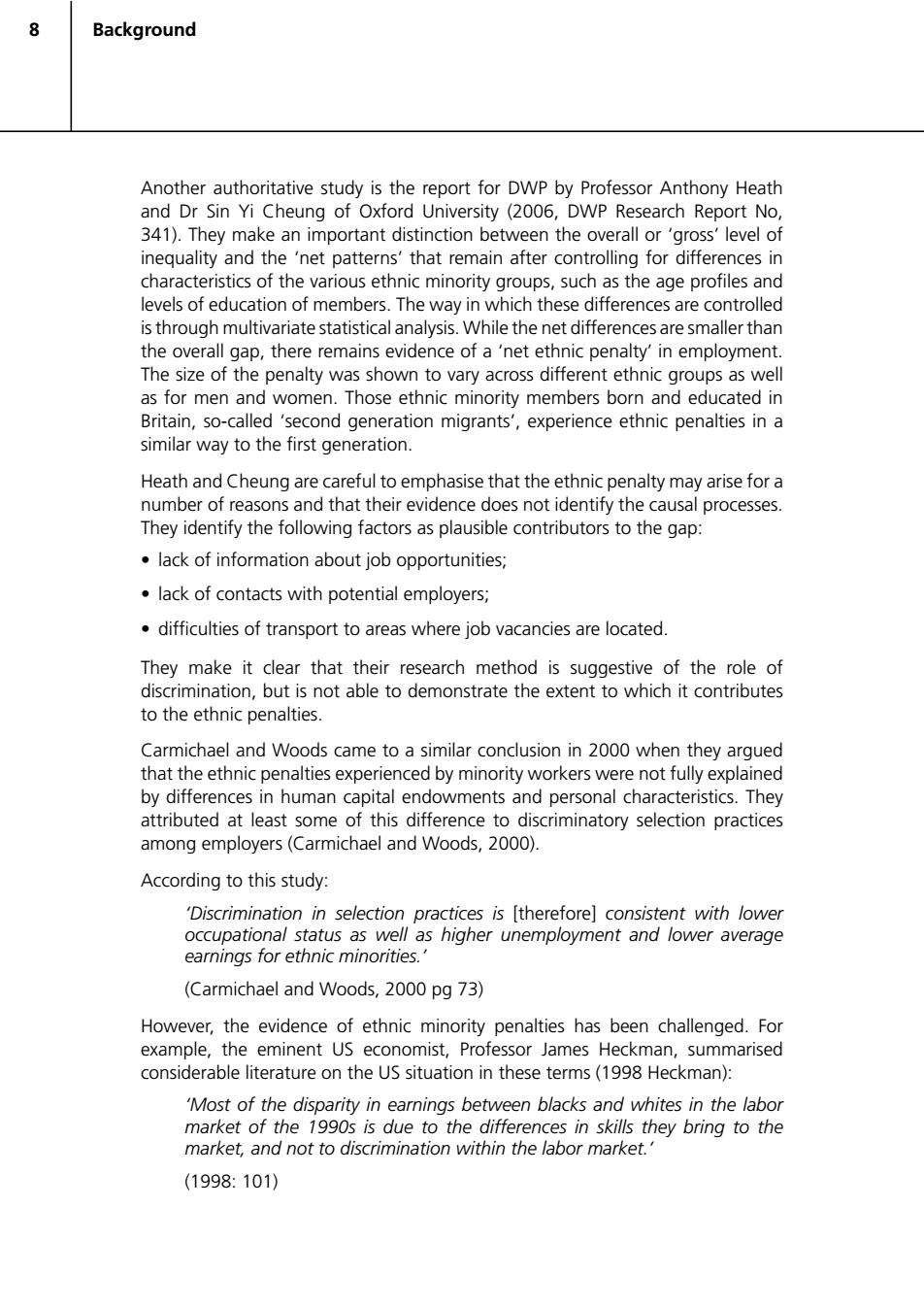正在加载图片...

8 Background Another authoritative study is the report for DWP by Professor Anthony Heath and Dr Sin Yi Cheung of Oxford University (2006,DWP Research Report No, 341).They make an important distinction between the overall or 'gross'level of inequality and the 'net patterns'that remain after controlling for differences in characteristics of the various ethnic minority groups,such as the age profiles and levels of education of members.The way in which these differences are controlled is through multivariate statistical analysis.While the net differences are smaller than the overall gap,there remains evidence of a'net ethnic penalty'in employment. The size of the penalty was shown to vary across different ethnic groups as well as for men and women.Those ethnic minority members born and educated in Britain,so-called 'second generation migrants',experience ethnic penalties in a similar way to the first generation. Heath and Cheung are careful to emphasise that the ethnic penalty may arise for a number of reasons and that their evidence does not identify the causal processes. They identify the following factors as plausible contributors to the gap: lack of information about job opportunities; lack of contacts with potential employers; difficulties of transport to areas where job vacancies are located. They make it clear that their research method is suggestive of the role of discrimination,but is not able to demonstrate the extent to which it contributes to the ethnic penalties. Carmichael and Woods came to a similar conclusion in 2000 when they argued that the ethnic penalties experienced by minority workers were not fully explained by differences in human capital endowments and personal characteristics.They attributed at least some of this difference to discriminatory selection practices among employers(Carmichael and Woods,2000). According to this study: 'Discrimination in selection practices is [therefore]consistent with lower occupational status as well as higher unemployment and lower average earnings for ethnic minorities.' (Carmichael and Woods,2000 pg 73) However,the evidence of ethnic minority penalties has been challenged.For example,the eminent US economist,Professor James Heckman,summarised considerable literature on the US situation in these terms(1998 Heckman): 'Most of the disparity in earnings between blacks and whites in the labor market of the 1990s is due to the differences in skills they bring to the market,and not to discrimination within the labor market. (1998:101)8 Another authoritative study is the report for DWP by Professor Anthony Heath and Dr Sin Yi Cheung of Oxford University (2006, DWP Research Report No, 341). They make an important distinction between the overall or ‘gross’ level of inequality and the ‘net patterns’ that remain after controlling for differences in characteristics of the various ethnic minority groups, such as the age profiles and levels of education of members. The way in which these differences are controlled is through multivariate statistical analysis. While the net differences are smaller than the overall gap, there remains evidence of a ‘net ethnic penalty’ in employment. The size of the penalty was shown to vary across different ethnic groups as well as for men and women. Those ethnic minority members born and educated in Britain, so-called ‘second generation migrants’, experience ethnic penalties in a similar way to the first generation. Heath and Cheung are careful to emphasise that the ethnic penalty may arise for a number of reasons and that their evidence does not identify the causal processes. They identify the following factors as plausible contributors to the gap: • lack of information about job opportunities; • lack of contacts with potential employers; • difficulties of transport to areas where job vacancies are located. They make it clear that their research method is suggestive of the role of discrimination, but is not able to demonstrate the extent to which it contributes to the ethnic penalties. Carmichael and Woods came to a similar conclusion in 2000 when they argued that the ethnic penalties experienced by minority workers were not fully explained by differences in human capital endowments and personal characteristics. They attributed at least some of this difference to discriminatory selection practices among employers (Carmichael and Woods, 2000). According to this study: ‘Discrimination in selection practices is [therefore] consistent with lower occupational status as well as higher unemployment and lower average earnings for ethnic minorities.’ (Carmichael and Woods, 2000 pg 73) However, the evidence of ethnic minority penalties has been challenged. For example, the eminent US economist, Professor James Heckman, summarised considerable literature on the US situation in these terms (1998 Heckman): ‘Most of the disparity in earnings between blacks and whites in the labor market of the 1990s is due to the differences in skills they bring to the market, and not to discrimination within the labor market.’ (1998: 101) Background